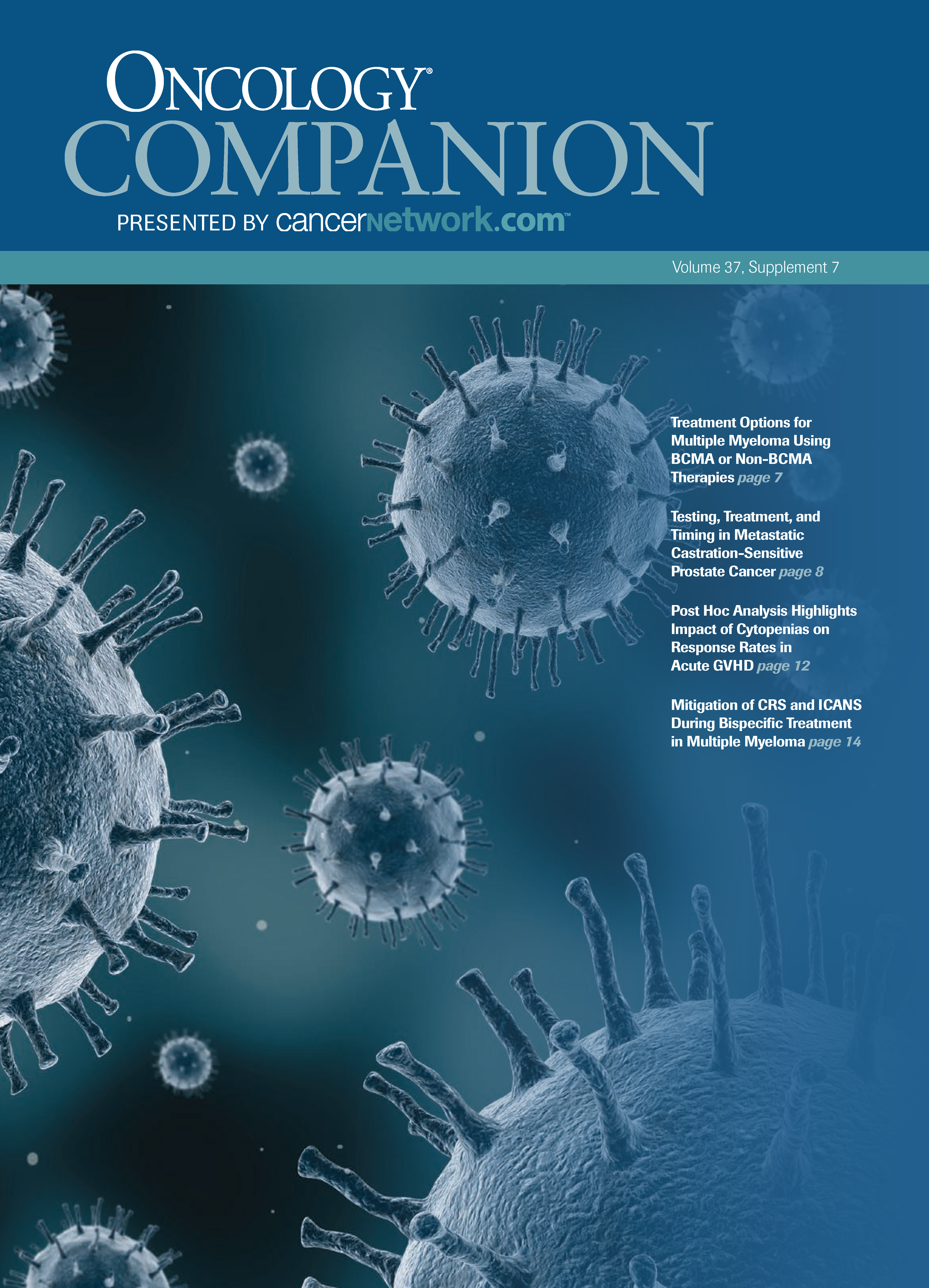Recap: Treatment Options for Multiple Myeloma Using BCMA or Non-BCMA Therapies
Publication
Article
ONCOLOGY® CompanionONCOLOGY® Companion, Volume 37, Supplement 7
Volume 37
Issue 7
Pages: 7
Key points from a discussion of the clinical data behind both BCMA- and non–BCMA-targeting bispecifics in multiple myeloma.

During a recent Training Academy program, hosted by CancerNetwork®, experts in multiple myeloma gathered to discuss recent trial updates regarding B-cell maturation antigen (BCMA) and non–BCMA-targeting bispecifics.
Trials to Know
BCMA Therapies
- Phase 2 MajesTEC-1 trial (NCT04557098)1:
- Subcutaneous teclistamab-cqyv (Tecvayli) at 1.5 mg/kg was given to patients with relapsed/refractory multiple myeloma after at least 3 lines of prior therapy, including triple-class exposure to an immunomodulatory drug, a proteasome inhibitor, and an anti-CD38 antibody.
- Results showed the overall response rate (ORR) was 63.0%, and 39.5% of patients had a complete response (CR) or better. The median duration of response was 18.4 months, and the median progression-free survival was 11.3 months.
- Phase 1 MagnetisMM-1 study (NCT03269136)2:
- The first-in-human study of elranatamab for patients with relapsed/refractory multiple myeloma. Patients were given elranatamab either at 215 to 1000 µg/kg weekly or every 2 weeks.
- Results included 64% of patients having an ORR and 35% of patients having a CR.
- Phase 1b TRIMM-2 trial (NCT04108195)3:
- Teclistamab plus daratumumab (Darzalex) was given to patients with relapsed/refractory multiple myeloma. Patients were given subcutaneous daratumumab at 1800 mg plus teclistamab at 1.5 to 3 mg/kg every week or every 2 weeks.
- Cytokine release syndrome was not an issue for this combination.
Non-BCMA Therapies
- Phase 2 MonumenTAL-1 trial (NCT04634552)4:
- Talquetamab was given at either 0.5 to 180 µg/kg intravenously every week or every other week; or 5 to 1600 µg/kg weekly, every other week, or monthly. This regimen is intended for patients with relapsed/refractory multiple myeloma who were heavily pretreated, had a median of 6 previous lines of therapy, or who could not receive these therapies without unacceptable adverse effects.
- A total of 70% of patients experienced a response at the 405-µg dose; 57% had a very good partial response (VGPR); and 23% had a CR. At the 800-µg dose, 64% had a response, 52% had a VGPR, and 23% had a CR.
- Phase 1 CAMMA 1 trial (NCT04910568)5:
- Cevostamab was given to patients with relapsed/refractory multiple myeloma who had less than 1 year of survival, had received more than 3 prior lines of therapy, and are triple drug refractory. Dosing ranged from 132 to 198 mg.
- The ORR was 56.7%. Enrollment for arm A is ongoing, and arms B and C are planned.
Key Pieces of Information
- In BCMA agents, infection is a chief concern, and intravenous immunoglobulin is given to responders.
- Quality of life is an important factor, and dose reductions may be considered to help these patients.
- Patients with renal insufficiency may receive chimeric antigegn receptor T-cell therapy, but questions remain regarding appropriate dosing.
References
- Moreau P, Garfall AL, van de Donk NWCJ, et al. Teclistamab in relapsed or refractory multiple myeloma. N Engl J Med. 2022;387(6):495-505. doi:10.1056/NEJMoa2203478
- Jakubowiak AJ, Bahlis NJ, Raje NS, et al. Elranatamab, a BCMA-targeted T-cell redirecting immunotherapy, for patients with relapsed or refractory multiple myeloma: updated results from MagnetisMM-1. J Clin Oncol. 2022;40(suppl_16):8014. doi:10.1200/JCO.2022.40.16_suppl.8014
- Rodriguez-Otero P, D’Souza A, Reece DE, et al. A novel, immunotherapy-based approach for the treatment of relapsed/refractory multiple myeloma (RRMM): updated phase 1b results for daratumumab in combination with teclistamab (a BCMA×CD3 bispecific antibody). J Clin Oncol. 2022;40(suppl 16):8032. doi:10.1200/JCO.2022.40.16_suppl.8032
- Chari A, Minnema MC, Berdeja JG, et al. Talquetamab, a T-cell–redirecting GPRC5D bispecific antibody for multiple myeloma. N Engl J Med. 2022;387(24):2232-2244. doi:10.1056/NEJMoa2204591
- Vij R, Schade H, Trudel S, et al. CAMMA 1: a multicenter phase Ib trial evaluating the safety, pharmacokinetics, and activity of cevostamab-containing regimens in patients with relapsed or refractory multiple myeloma. J Clin Oncol. 2022;40(suppl 16):TPS8069. doi:10.1200/JCO.2022.40.16_suppl.TPS8069
EP: 1.BCMA-Targeting Bispecifics in Multiple Myeloma: Teclistamab
EP: 2.BCMA-Targeting Bispecifics in Multiple Myeloma: Elranatamab
EP: 3.The Evolving Role of BCMA-Targeting Bispecifics in Multiple Myeloma
EP: 4.Multiple Myeloma: Selecting Among the BCMA-Targeting Therapies
EP: 5.BCMA-Targeting Bispecifics in Multiple Myeloma: Safety Profile
EP: 6.Non-BCMA-Targeting Bispecifics in Multiple Myeloma: Talquetamab
EP: 7.Non-BCMA-Targeting Bispecifics in Multiple Myeloma: Cevostamab
EP: 8.The Evolving Role of Non-BCMA-Targeting Bispecifics in Multiple Myeloma
EP: 9.Multiple Myeloma: Use of Bispecifics in Challenging Patient Populations
Now Viewing
EP: 10.Recap: Treatment Options for Multiple Myeloma Using BCMA or Non-BCMA Therapies
Articles in this issue

Recap: Testing, Treatment, and Timing in Metastatic Castration-Sensitive Prostate Cancer
Recap: Mitigation of CRS and ICANS During Bispecific Treatment in Multiple Myeloma
Recap: Treatment Options for Multiple Myeloma Using BCMA or Non-BCMA Therapies
Recap: Post Hoc Analysis Highlights Impact of Cytopenias on Response Rates in Acute GVHD
Related Content